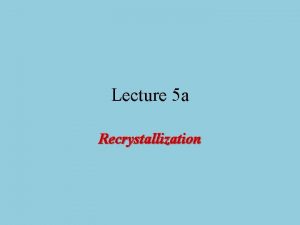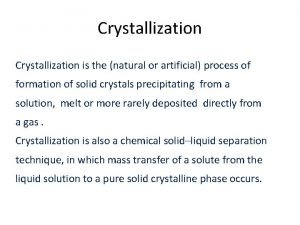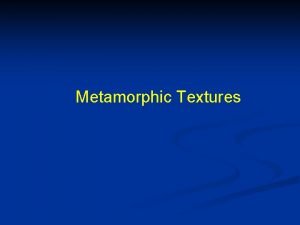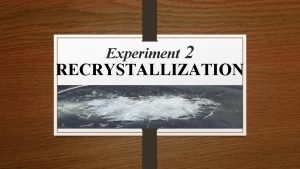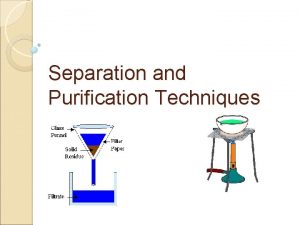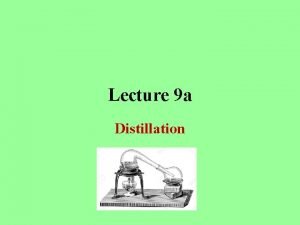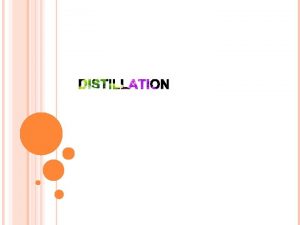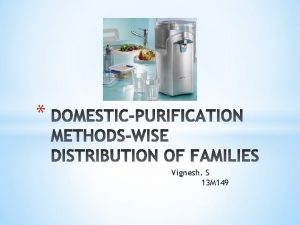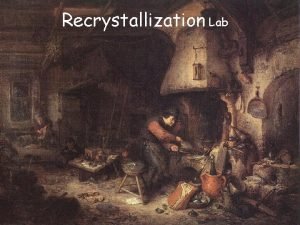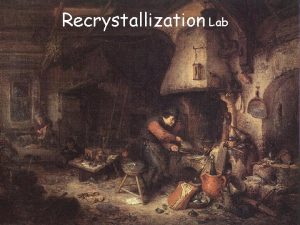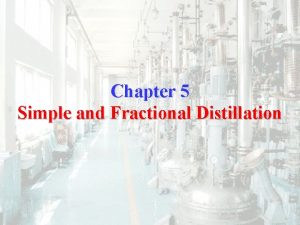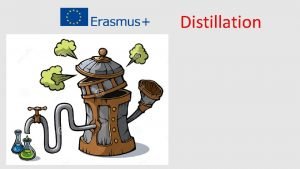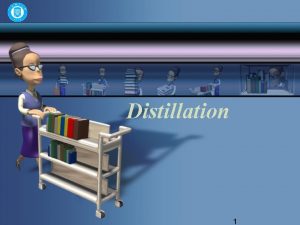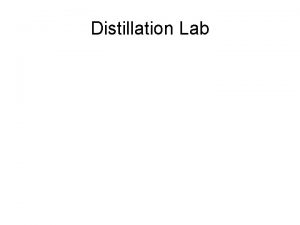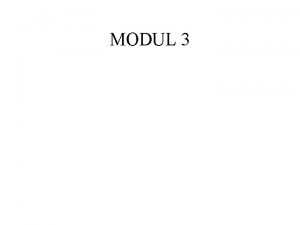Lecture 5 a Recrystallization Introduction Purification Techniques Distillation









- Slides: 9

Lecture 5 a Recrystallization

Introduction • Purification Techniques • • • Distillation: liquids, gases, some solids Sublimation: solids only Recrystallization: solids mainly Chromatography: solids, liquids, gases Extraction: mainly liquid-liquid (often involves acid-base chemistry), sometimes solid-liquid • Zone melting i. e. , purification of silicon, etc.

Theory of Recrystallization I • Dissolution • Breaking solute-solute attractions (endothermic) • Breaking solvent-solvent attractions (endothermic) • Forming solvent-solute attractions during the DH(sol) solvation process (exothermic but with varying degrees depending on the type of interaction between solute and solvent) • The entropy increases usually during the dissolution process • Most dissolution processes of organic compounds are endothermic unless strong bonds (i. e. , hydrogen bonds) are formed between the solute and the solvent • Precipitation • This step requires the loss of the solvent cage (endothermic) • Ordered packing of the target compound (exothermic)

Theory of Recrystallization II • Three basic scenarios are possible for the solution behavior (the graphs are linear to show the trends only): Solubility • Case 1: The compound dissolves poorly at all temperatures. • Case 2: The compound dissolves well at all temperatures. • Case 3: The compound dissolves well at high temperatures but poorly at low temperatures. Temperature

Theory of Recrystallization III • How do we pick a solvent? • Goal: The target compound should exhibit a steep solubility curve in the solvent (case 3), while the impurity (ideally) dissolves well at all temperatures (case 2). • The recrystallization solvent has to have a somewhat different polarity compared to the target compound but ideally be similar to polarity of the impurity (“Like-dissolves-like”). • Example 1: Separation of benzil (weakly polar) and benzoin (medium polar): • To isolate benzil: 95 % ethanol, methanol • To isolate benzoin: benzene, CCl 4

Theory of Recrystallization IV • Solvent mixtures • They will be used if a single solvent is not available for recrystallization. • They allow to fine-tune solubility behavior (i. e. , steepness of curve). • The composition of the mixture will change if the mixture is boiled too long because the lower boiling solvent will evaporate. Example 2: TPCP (weakly polar) Solubility • Toluene (b. p. = 111 o. C) Toluene: 95 % Ethanol (2: 1) Toluene: 95 % Ethanol (1: 1) impurity 95 % Ethanol (b. p. = 78 o. C) Temperature

Procedure I • Place the crude solid in an Erlenmeyer flask of proper size • Add a small amount of the cold solvent to the solid • Why is this important? To minimize the loss of solvent and target compound • How much solvent should be added? About half of what was calculated • Add a spin bar or boiling stick • Why are they added? To avoid bumping to the suspension • Place a watch glass with some • Why is the watch glass ice cubes on the top placed on the top? To condense the solvent • Heat the mixture to a gentle boil • What is the student looking for? The entire crude dissolves

Procedure II • After the entire solid is dissolved, remove the flask from the hotplate • Allow the saturated solution to cool down to room temperature slowly • Place the solution/mixture in an ice-bath • Isolate the crystals by vacuum filtration • Rinse the crystals with a small amount of ice-cold solvent • Why is it important that the entire solid dissolved? To dissolve the impurities • Why is the solution cooled down slowly? To obtain better quality crystals • Why is the mixture place in an ice-bath? • Review vacuum filtration • How much is appropriate here? 1 -2 m. L

Troubleshooting • Which steps should be taken if no precipitates forms upon cooling? • Remove some of the solvent to get a more concentrated solution. • Scratch the insides of the Erlenmeyer flask with a glass rod to produce some glass powder that can act as a seed. • Add seeds crystals to the solution. • Add a solvent that lowers the solubility of the target compound and keeps the impurities in solution.
 Recrystallization theory
Recrystallization theory Multi solvent recrystallization
Multi solvent recrystallization Schistocity
Schistocity Decolorizing charcoal recrystallization
Decolorizing charcoal recrystallization Soft
Soft Simple distillation vs fractional distillation
Simple distillation vs fractional distillation Fractional distillation vs destructive distillation
Fractional distillation vs destructive distillation Protein characterization methods
Protein characterization methods Introduction of purification of water
Introduction of purification of water 01:640:244 lecture notes - lecture 15: plat, idah, farad
01:640:244 lecture notes - lecture 15: plat, idah, farad
